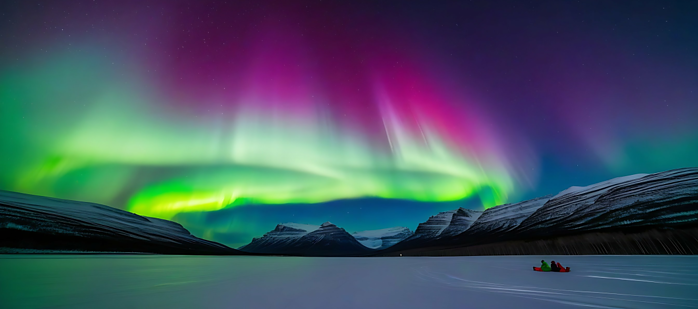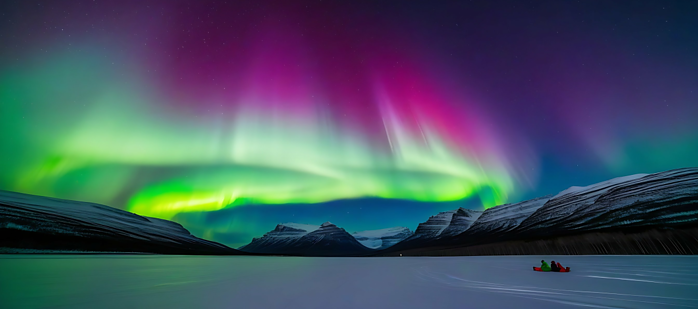
AI-generated image of northern lights. Note. Image generated with the prompt “Image of The Northern Lights” by Freepik, 2024
The Northern Lights, known scientifically as the Aurora Borealis, are a spectacular light show that nature provides against the night sky. This phenomenon occurs when electrically charged particles from the sun collide with gases in the Earth’s atmosphere, creating vibrant curtains of color that captivate observers.
Historically, various cultures have woven fascinating myths around auroras, attributing them to everything from dancing spirits to the gleam of a fabled celestial fox’s tail. These lights have been a marvel and a source of inspiration, influencing art, folklore, and religious experiences across civilizations.
Today, scientists have unraveled many mysteries behind this majestic phenomenon, yet it continues to intrigue and attract people from around the world. The impact of the Northern Lights is not confined to the night sky; it extends into the realms of tourism and photography and even drives scientific innovation and eco-consciousness.
Stepping into the world of this celestial dance, I’ll explore the rich history and the modern scientific understanding of the Northern Lights. This fusion of culture and science sets the stage for a deeper appreciation of one of nature’s most wondrous displays. You’ll discover how solar winds shape these lights and what recent studies tell us about the shifting patterns above.
The Science Behind the Curtains of Light
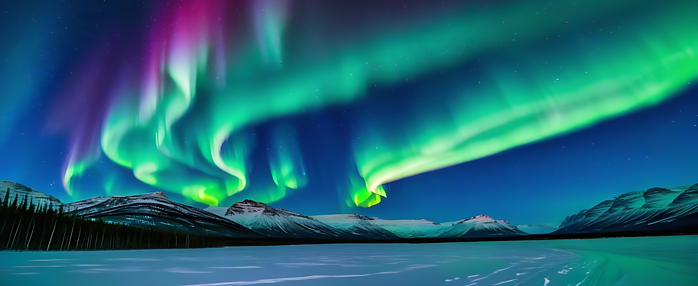
AI-generated image of northern lights. Note. Image generated with the prompt “Image of The Northern Lights” by Freepik, 2024
You might think of the Northern Lights as mere sky art, but there’s a fascinating interplay of science at work. At its core, this natural light display results from collisions between the Earth’s atmosphere and charged particles from the sun.
The Earth’s magnetosphere, an invisible shield, plays a pivotal role. It protects us from the solar wind, a stream of charged particles rushing from the sun at about 1 million miles per hour. When solar winds reach Earth, they’re met by the magnetosphere, distorted by their force.
Some of the solar particles slip past this shield and collide with gases in our atmosphere. Oxygen and nitrogen atoms, excited by these energetic collisions, release photons — tiny packets of light — as they calm down. This is what paints those brilliant strokes across the Arctic skies.
What about the different colors? They’re determined by which gas is being hit and how high the action is taking place in the atmosphere. Oxygen above 150 miles gives off a rare, all-red aurora, while the common yellowish green is produced by oxygen up to 150 miles. Nitrogen contributes blue and purplish-red hues.
These natural light shows aren’t static, either. They change in shape and intensity. The variations result from interactions with the magnetic and electrical forces in the Earth’s magnetosphere. Complex and dynamic, each display is unique.
I’d also like to highlight recent studies that have significantly improved our understanding of these lights. Researchers are employing new satellite technologies and ground-based equipment to unravel the auroras’ mysteries, such as how exactly solar storms influence them.
These scientific endeavors unearth more than just facts about the Northern Lights. They also expand our knowledge of solar-terrestrial relations and how space weather impacts Earth. This research holds practical implications, from safeguarding satellites and power grids to improving communication systems.
Experiencing the Northern Lights: When and Where
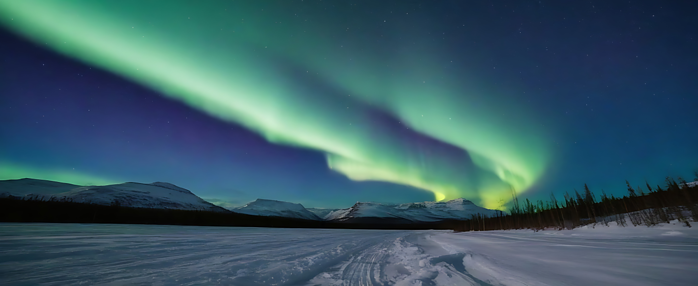
AI-generated image of northern lights. Note. Image generated with the prompt “Image of The Northern Lights” by Freepik, 2024
Imagine standing under a vast, dark sky as ethereal hues of green, purple, and pink dance above you – this is the magnetic allure of the Northern Lights. You may be eager to witness this spectacle, and rightly so. But how do you go about it? Knowing when and where to go is critical to catching the aurora in its full glory.
First, focus on geographical sweet spots. The auroral oval is your target, essentially an area with high aurora activity. This oval hovers over the Magnetic North, making Northern Norway, Iceland, Canada’s Yukon, and Alaska prime spots. Yet, don’t rule out the southern reaches, as Tasmania and New Zealand offer a southern counterpart, the aurora australis, with fewer crowds.
You’ll want to time your adventure during the equinoxes, when activity peaks, specifically from September to April. Long, clear winter nights provide the best backdrop for the Northern Lights. The puzzle is that nature is unpredictable. Thus, planning a stay of several nights increases your chances of catching the light show.
Next, the magnetic solar cycle plays its part—a roughly 11-year rhythm that affects aurora visibility. Aligning your trip with the peak of this cycle could boost your chances, but it’s not a strict rule. Auroras can still stun any given night, given the right solar winds.
Consider how you’ll document this moment once the where and when are settled. Your ordinary camera won’t suffice for Northern Lights photography. You’ll need a camera with manual settings, a tripod for stability, and patience to adjust for long exposure shots. This way, you can capture the moment to relive and share.
As we wrap up this section, think about this: the Northern Lights are more than just a visual feast—they’re a bridge to local cultures and economies. Your visit contributes to tourism that supports remote communities. But as you look forward to your journey, remember that it’s part of a larger cycle of celestial discovery and preservation, which we will explore in the next section.
Preserving the Wonder: The Future of Auroral Research
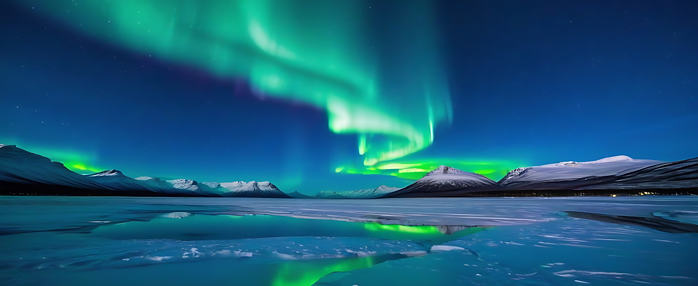
AI-generated image of northern lights. Note. Image generated with the prompt “Image of The Northern Lights” by Freepik, 2024
The Northern Lights aren’t just a stunning spectacle; they’re a dynamic canvas that tells the ongoing story of our planet’s interaction with the sun. As I reflect on their beauty, I’m reminded of the importance of preserving this natural wonder for future generations to experience and study.
First, it’s essential to understand the challenges. Light pollution and climate change threaten the visibility and existence of the aurora borealis. Brightening night skies from urban areas can obscure our view, while shifts in climate patterns may alter the behaviors of auroras we’re still endeavoring to understand fully.
Thankfully, the preservation of the Northern Lights has not gone unnoticed. The scientific community is leveraging advanced technology for better prediction models, and research observatories are continually gathering data to understand more about this natural phenomenon.
In addition, global collaborations are more vital than ever, pooling resources and intellect from around the world. This collective effort not only aids in the study of auroras but also in crafting policies and practices to mitigate the adverse effects of human activity on our atmosphere.
Educational outreach is a critical component, too. By engaging the public in auroral science, authorities can foster a sense of stewardship and encourage behaviors that support conservation efforts. Whether through public talks, interactive exhibits, or citizen science projects, increasing awareness is a powerful tool in the fight to protect our night skies.
Lastly, it’s about personal responsibility. Remember, every one of us can play a part in this. Choosing dark-sky-friendly lighting, minimizing energy consumption, and supporting conservation initiatives are simple yet effective steps.
As we unravel the mysteries of the aurora borealis, it’s clear that their story isn’t just written in the stars—it’s also in our hands. By acting today, we ensure that the enthralling dance of the Northern Lights remains a source of inspiration and intrigue well into the future.
For additional blog posts, please visit:
Northern Lights Shutter Tech – Capture the Magic Gear & Expertise

